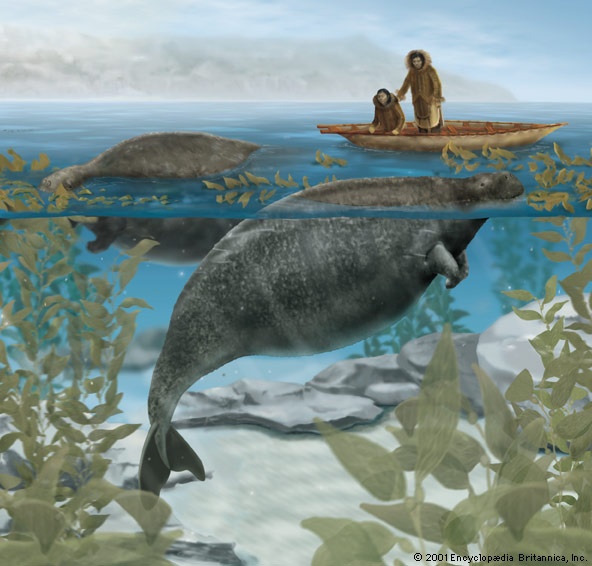sea cow
mammal
also called Steller's sea cow
 very large aquatic mammal, now extinct, that once inhabited nearshore areas of the Komandor Islands in the Bering Sea. Steller's sea cows were wiped out by hunters in the 18th century less than 30 years after they were first discovered by Arctic explorers. Today, the term sea cow is sometimes used to refer to other sirenians (sirenian), namely, the manatee and the dugong.
very large aquatic mammal, now extinct, that once inhabited nearshore areas of the Komandor Islands in the Bering Sea. Steller's sea cows were wiped out by hunters in the 18th century less than 30 years after they were first discovered by Arctic explorers. Today, the term sea cow is sometimes used to refer to other sirenians (sirenian), namely, the manatee and the dugong.Steller's sea cow was unknown to science until 1741, when it was described by German naturalist Georg W. Steller, who accompanied Vitus Bering (Bering, Vitus) on his voyage of discovery in the North Pacific. No preserved specimens exist today, but the sea cow was certainly the largest sirenian. Reaching a length of 9–10 metres (over 30 feet) and a weight of perhaps 10 metric tons (22,000 pounds), it was much larger than present-day manatees and dugongs (dugong). Like the dugong, the sea cow had a relatively small head and a broad, horizontal forked tail fluke. Small stumpy flippers near the front of the body were used for moving over rocky areas and for holding fast to rocks in rough seas. The barklike skin was dark brown, sometimes streaked or spotted with white. Sea cows had no teeth; instead, they relied on horny plates in the mouth to compact their soft food, which consisted of kelp and seaweed near the ocean's surface along the shore. They floated at the surface but had little ability to submerge and thus were easy targets for harpooning by hunters. The sea cow was used to supply Russian seal hunters with prized meat on long sea journeys, and killing was often wasteful. The total population in 1741 has been estimated at about 2,000, but by 1768 it had been exterminated. The extinction of Steller's sea cow is a dramatic example of the vulnerability of small isolated animal populations.
Steller's sea cow belonged to the same family as the dugong (family Dugongidae). The dugong and manatee families both belong to the order Sirenia, but Steller's sea cow was one of the few sirenians ever to inhabit cool waters. The extremely large size of Steller's sea cow functioned as an adaptation for survival in cool waters by providing the animal with a smaller ratio of surface area to volume than tropical sirenians, and the thick hide probably provided better insulation.
- Linux
- Lin Yutang
- Linz
- Lin Zexu
- Linzi
- Linz program
- lion
- Lionel-Adolphe Groulx
- Lionel Barrymore
- Lionel Charles Robbins, Baron Robbins
- Lionel Charles Robbins Robbins, Baron
- Lionel Conacher
- Lionel Cranfield, 1st earl of Middlesex
- Lionel Cranfield Middlesex, 1st earl of
- Lionel George Curtis
- Lionel Hampton
- Lionel Jospin
- Lionel Lukin
- Lionel of Antwerp Clarence, duke of
- Lionel of Antwerp, duke of Clarence
- Lionel Rose
- Lionel Trilling
- Lionel Walter Rothschild, 2nd Baron Rothschild
- Lionel Walter Rothschild Rothschild, 2nd Baron
- Lion Feuchtwanger